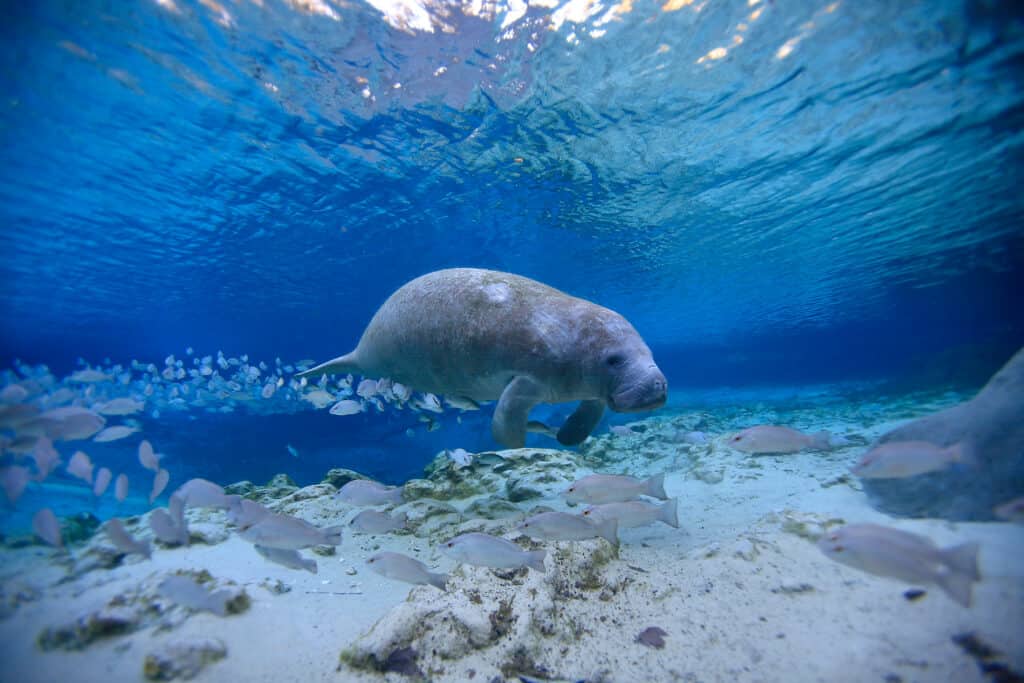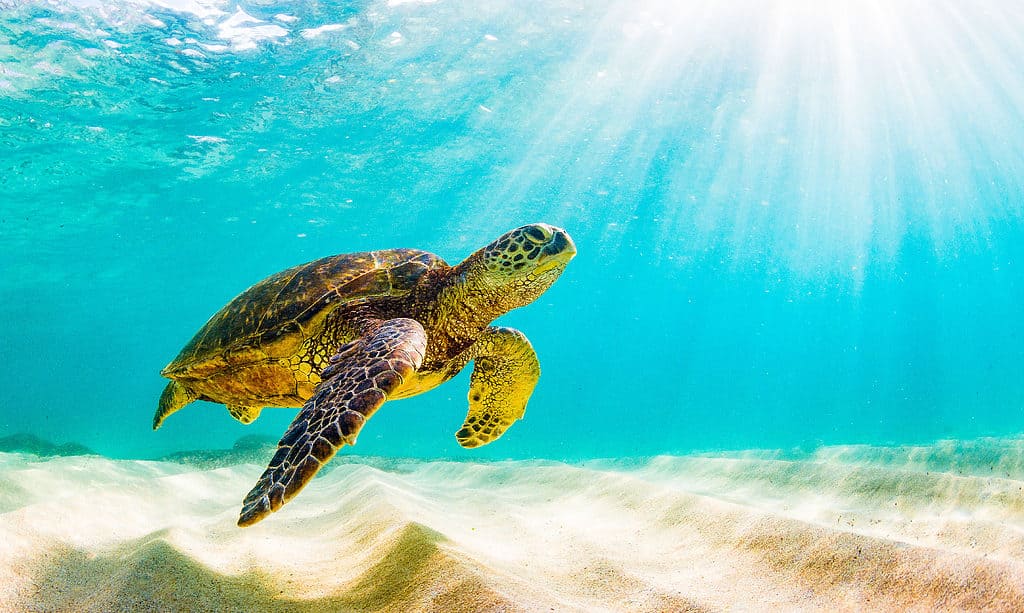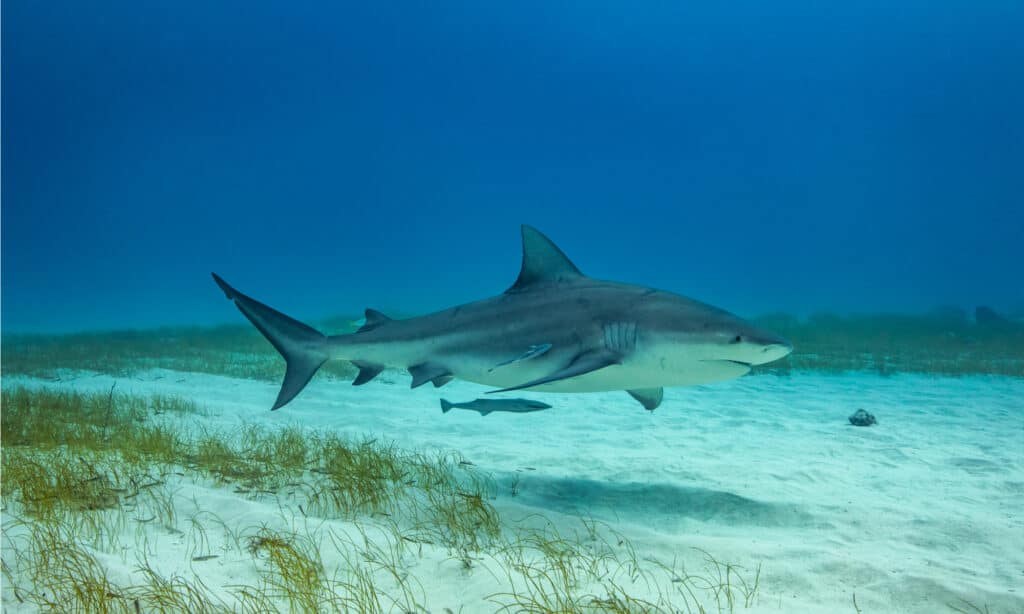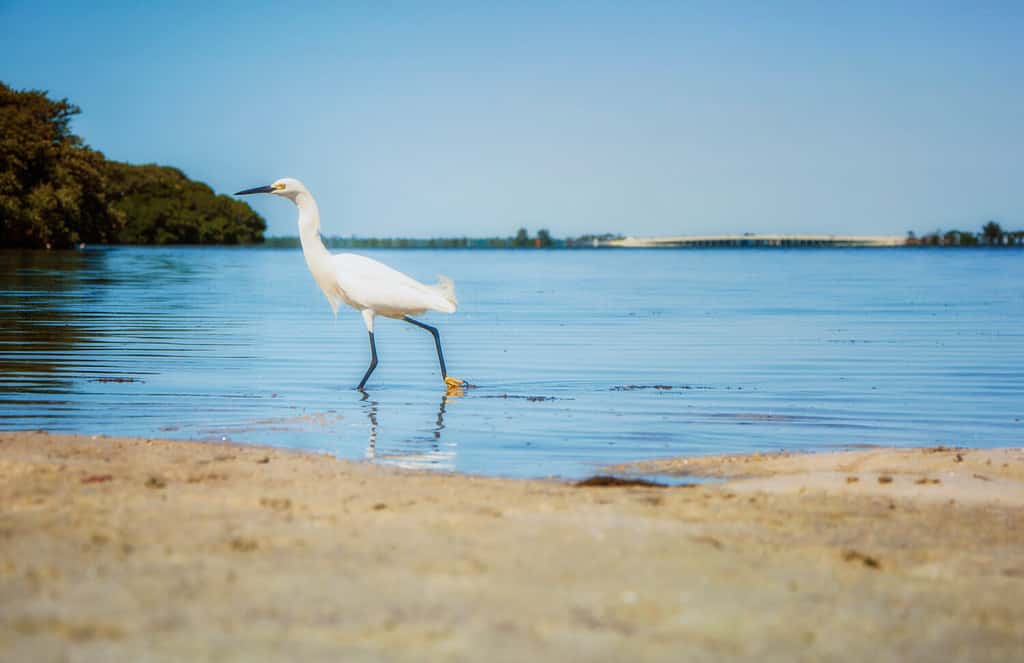The largest open-water estuary in Florida, Tampa Bay is the gateway to the Gulf of Mexico (a marginal sea of the Atlantic Ocean), for over 100 tributaries, including four major rivers. It covers almost 400 square miles and is an important ecological site for over 200 species of fish. But just how deep is Tampa Bay?
On average the bay measures about 12 feet deep. This is its natural average depth. However, to allow large ships passage to the Port of Tampa and other harbors, manmade channels have been dredged. The deepest area dredged in Tampa Bay is the main shipping channel. This channel measures 43 feet deep and 40 miles long.
Read on to learn about the history of the Tampa Bay region, popular recreation activities and hotspots, and the plants and animals that live along the shores and in its waters.

The average depth of Tampa Bay is about 12 feet, although manmade channels reach up to 43 feet deep.
©Mntneerjay / CC-BY-SA 3.0 – License
The Founding of Tampa
Before colonization, the main tribes who inhabited the areas in and around so-called Tampa, Florida, were the Mocoso, Tocobaga, Pohoy, and Uzita. In the early-to-mid 1500s, Juan Ponce de Leon, Panfilo de Narvaez, and Hernando de Soto led viciously genocidal campaigns against the tribes living around Tampa Bay. Most of the indigenous people who survived these colonial attacks succumbed to novel diseases spread by the European settlers. After about 30 years of horrors enacted against the native people of this land, the conquistadors set their sights on eastern Florida, leaving the Tampa Bay area in their wreckage.
A consolidated colonial campaign against the region didn’t begin again in earnest until the early 1800s when the U.S. took control of Florida and forced many of the remaining native people of the region into reservations through the coerced signing of “treaties”. Soon after, in 1824, the U.S. Army established Fort Brooke to assert and maintain its control over the Tampa Bay harbor. On January 18th, 1849, authorities of the colonial state officially incorporated the area as the Village of Tampa.
Ecology of Tampa Bay
While colonization, industrial civilization, and rampant development have destroyed much of the wild places around Tampa Bay, a delicate ecosystem still exists and persists. Mangrove forests, salt marshes, and seagrass beds provide crucial habitats for native and naturalized mammals, reptiles, amphibians, birds, and fish. Over 200 species of fish and 325 species of birds are known to depend upon this estuary.
Below, we’ll talk about some of the amazing critters and plants that call the Tampa Bay home.
Florida Manatee (Trichechus manatus latirostris)
The Florida manatee (Trichechus manatus latirostris) is one of two subspecies of the West Indian manatee (Trichechus manatus). These large, gray, and gentle aquatic mammals, affectionately nicknamed sea cows, are protected under the Endangered Species Act and the Marine Mammal Protection Act. The major threats to the Florida manatee are devastating loss of habitat due to aggressive development, water pollution, fishing gear entanglement, industrial civilization-caused climate change, and collisions with boats and ships.
About 7,500 Florida manatees remain in the wild. Since 2020, these gentle giants are close relatives of elephants and can live up to about 70 years. Typically adult manatees grow up 9-10 feet long and weigh about 1,000 pounds. Less commonly, they can reach over 13 feet in length and weigh over 3,500 pounds. They reside throughout rivers, springs, and coastal waters in Florida, including Tampa Bay. In coastal waters, these gentle creatures depend on grazing upon shallow beds of seagrass. These habitats must be vigorously restored and protected to support the survival of the Florida manatee.

The Florida Manatee inhabits rivers, springs, and coastal waters throughout Florida, including Tampa Bay.
©Thierry Eidenweil/Shutterstock.com
Green Sea Turtle (Chelonia mydas)
Another marine animal that feeds on the seagrass beds of Tampa Bay is the green sea turtle (Chelonia mydas). As a uniquely herbivorous sea turtle, the seagrass beds are a critical habitat and source of food for this endangered species.
This widespread sea turtle is widely distributed across tropical and subtropical oceans around the world. They nest on the shores of more than 80 countries and live in the coastal waters of over 140 countries. Global populations of the green sea turtle sharply declined over the past 50 years. This is mainly due to bycatch, ship strikes, industrial civilization-fueled climate change, poaching for shells and eggs, and destruction of nesting habitats.
In the Tampa Bay area, green sea turtles nest between June and September. Heavy development along the coast of Tampa Bay brings great danger to thousands of sea turtle hatchlings. When sea turtles hatch at night, they rely on the downward slope of the beach and the reflection of the stars and moon on the water to guide them to the ocean. Tragically, artificial lighting from vehicles, buildings, and street lighting disorient the hatchlings, often sending them the wrong way into injury and death. Protecting and restoring shorelines is crucial to the green sea turtles that nest on the shores and spend part of their lives in the waters of Tampa Bay.

The green sea turtle is an endangered species that feeds on the seagrass beds found in the shallow waters of Tampa Bay.
©iStock.com/ShaneMyersPhoto
Animals of Tampa Bay: Bull Shark (Carcharhinus leucas)
The bull shark (Carcharhinus leucas) is a common resident of the waters of Tampa Bay. This magnificent shark uses the shallow waters of the bay to hunt and as a nursery for bull shark pups. Where the Alafia River meets Tampa Bay is a hotspot nursery ground for bull sharks. These sharks can withstand the lower salinity of this estuary environment. The ability to tolerate freshwater and low salinity environments is due to a gland near their tails that allows them to retain salt and kidneys adapted to recycling salt when they enter freshwater.
Bull sharks are the most common in these coastal waters from April through October. Typically, adult bull sharks range from 7-12 feet in length and weigh 200-500 pounds. They have distinctly short, blunt snouts. Their average lifespan is 12-16 years.

Bull sharks are commonly found in the waters of Tampa Bay from April to October.
©Carlos Grillo/Shutterstock.com
Mangrove Forests of Tampa Bay
There are three species of mangroves, a tropical wetland tree, that grow along various areas of the Tampa Bay shoreline. These three species, which are native to Florida, are the red mangrove (Rhizophora mangle), the black mangrove (Avicennia germinans), and the white mangrove (Laguncularia racemosa). These tropical plants are adapted to thriving in loose, saturated soils, and up-taking salt water through their roots.
Mangroves serve several vital ecological roles in estuary environments such as the coastal waters of Tampa Bay. Mangrove forests trap and recycle organic matter, elements, and nutrients back into the coastal ecosystem. They serve as a protective habitat, nursery area, and feeding ground for a wide range of marine and coastal animals. Additionally, their presence provides wind and wave-reducing protection along shallow shorelines during severe weather.
Tampa Bay Recreation
There are a plethora of recreation opportunities in and along Tampa Bay. Kayaking, paddle boarding, swimming, boating, snorkeling, sunbathing, and wildlife-watching are some popular activities for beachgoers of Tampa Bay. If you do decide to swim in Tampa Bay, it’s safest to swim in groups during the day.
Great places to visit to observe wildlife and enjoy a more secluded area are the Tampa Bay Estuarine Ecosystem Rock Ponds Area, Cockroach Bay Aquatic Preserve, and the Terra Ceia Preserve State Park. Some popular beaches of Tampa Bay include Gardenville Beach, Davis Island Dog Beach, Fort de Soto, and Ballast Point Park.

Fort de Soto is one of several excellent beaches along the coast of Tampa Bay.
©GB Design Den/Shutterstock.com
The photo featured at the top of this post is © Sean Pavone/Shutterstock.com
Thank you for reading! Have some feedback for us? Contact the AZ Animals editorial team.






